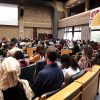Friday, May 10, 2024
News and Views from the Global South
HEALTH-NEPAL: Monsoon Rains Bring Illnesses
Surendra Phuyal
- On a recent afternoon, Dhana Maya Shrestha limped into the medical ward at the Shukraraj Tropical Hospital here in the Nepali capital, as the nurses gave her a new bottle of saline water.
‘’Many people in our village came down with cholera,’‘ said the 35-year-old mother of two from Dhading hills, her voice low as she lay in bed. ‘‘We don’t know why.’‘
Although many patients suffering from cholera got better after receiving medical treatment at the local health post in her remote village in central Nepal, Shrestha had to be rushed to the capital city, about 60 kilometres away from her village.
Doctors say a cholera epidemic spread in her village after the locals took contaminated water – the sources of drinking water had been flooded with monsoon waters. They blame poor hygiene and sanitation and incessant monsoon rains that trigger floods and landslides for the spread of such epidemics.
In Shrestha’s home district in Dhading alone, nine people died and nearly a thousand suffered. Across this Himalayan kingdom, more than 290 have died and nearly 18,000 suffered from such monsoon-time epidemics like diarrhoea and cholera, according to figures made available by the Department of Health Services.
In fact, the monsoon heaps a multitude of problems on Nepal, already dealing with a Maoist insurgency and most recently, a one-week blockade by the rebels around Kathmandu valley, lifted on Aug. 25, that had sent the prices of goods up.
Monsoon rains trigger landslides, displace or bury people, leave a trail of destruction. This year monsoon disasters claimed the lives of well over 100 people – minus those affected by gastro-related epidemics. The spate of disasters lasts through September, and are routine.
‘‘But the situation today is much better than it was ten years ago,’‘ says Dr Mahendra Bahadur Bista, director at the division. ‘‘In the early 1990s, we would have tens of thousands of people falling sick of gastro-related ailments at a given time.’‘
Badly affected it may be from an eight-year-old insurgency that has claimed the lives of over 10,000 people, Nepal has a network of health posts and centres in all 75 districts. To control epidemics like diarrhoea, cholera and encephalitis, the government has formed rapid response teams comprising paramedics in all the districts.
‘‘They are on stand by and they have been kept ready, so epidemics are now under control,’‘ sighs Bista, as he sits in his office and shouts to call in a helper to fax a new progress report to all the concerned ministries and the media. ‘‘We dispatched medicines and teams of paramedics to the most affected districts and everything is all right now.’‘
As monsoon rains raged, and rivers and streams swelled in towns and villages across Nepal, reports of natural disasters and epidemics started pouring in.
Some districts most affected by gastro epidemics are Achham in the far west, where these claimed the lives of 33 people, while affecting nearly 1,000. In Humla in the mid west, 23 people died while nearly 500 were affected, according to health ministry figures.
In Achham, one of Nepal’s poorest and remotest districts now badly affected by the Maoist insurgency, the epidemics affected several mountain settlements and villagers were dying due to a lack of medicines, according to Dr Shankar Bahadur Shrestha, who led an emergency response team there.
‘‘If we can educate the people, and ensure safe drinking water to them, we can literally put a stop to such epidemics,’‘ he said. ‘‘We also need to make sure that there’s enough stock of medicine, and that there are paramedics at the health posts.’‘
But many personnel in health posts and district hospitals in remote areas of Nepal are deserting their jobs because of security fears from the insurgency.
Still, other experts say ensuring basic needs such as safe drinking water to the populations living in remote areas and urban slums would go a long way in checking the spread of the routinely occurring epidemics.
Government figures say 80 percent of Nepalis have access to safe drinking water, but not everybody agrees. ‘‘That’s just a number, the ground reality is something else,’‘ said Dr Roshan Raj Shrestha, a water expert at Environment and Public Health Organisation (ENPHO), a Kathmandu-based non-profit organisation.
Likewise, only 25 percent of the population enjoy basic sanitation facilities and most of the rest defecate in the open. This makes water-borne communicable diseases the most common public health problem.
Even in Kathmandu, in June, hundreds of people were affected by a gastro-related epidemic. That, officials admitted, was fuelled by a leakage in Kathmandu’s archaic drinking water supply network, which crosses the city’s sewerage network.
But this can change once leaks are plugged, and aggressive hygiene, sanitation and safe water campaigns are launched.
‘‘A small step aimed at increasing the awareness level of the households can make a huge difference,’‘ Shrestha of ENPHO said.
Shrestha’s group has launched a unique campaign to make safe water accessible to all at zero cost. His water treatment method is simple: fill a plastic bottle with water, expose it in the sun for six-to-seven hours, and it’s 100 percent safe.
Yet, who will popularise this method among the public û the lethargic health ministry officialdom or the many NGOs û is not clear.
‘‘If they had enough medicines and saline water in our health post, maybe I didn’t have to be rushed all the way here for treatment,’‘ said Shrestha. ‘‘We live in the hills, in the corners, we need more knowledge and support from the government at the centre.”

 Print
Print



